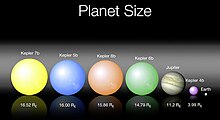Kepler-7b
[2] It orbits a star slightly hotter and significantly larger than the Sun that is expected to soon reach the end of the main sequence.
Its equilibrium temperature, due to its proximity to its star, is hot and is measured at nearly 1540 K. However, of the first five planets discovered by Kepler, it is the second coolest, being surpassed only by Kepler-6b.
[4] Astronomers using data from NASA's Kepler and Spitzer space telescopes have created a cloud map of the planet.
Kepler's visible-light observations of Kepler-7b's Moon-like phases led to a rough map of the planet that showed a bright spot on its western hemisphere.
Thomas Barclay, Kepler scientist at NASA's Ames Research Center, said: "Unlike those on Earth, the cloud patterns on this planet do not seem to change much over time—it has a remarkably stable climate.
[15] In 2009, NASA's Kepler space telescope was completing the last of tests on its photometer, the instrument it uses to detect transit events, in which a planet crosses in front of and dims its host star for a brief and roughly regular period of time.
Kepler-7's candidate was not found to be one of these false positives, such as an eclipsing binary star that may generate a light curve that mimics that of transiting planetary companions.
Speckle imaging of the star was taken at WIYN Observatory in Arizona to check for close companions; when none were found, the High Resolution Echelle Spectrometer instrument at the W.M.

